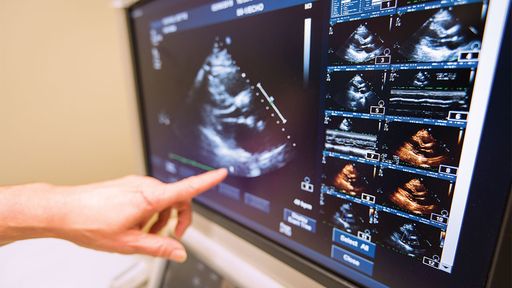
While cardiac toxicity from chemotherapy treatments is a known challenge in oncology, previous imaging techniques have sometimes missed spotting affected patients. Now, a novel imaging technology, speckle tracking echocardiography, allows for earlier and more accurate monitoring of heart function in a variety of oncology patients (Tex Heart Inst J 2020;47[2]:96-107).
“Although cardiology assessment of oncology patients is a rather new specialty, the effect of certain chemotherapy drugs on the heart has been known for many years,” said Jay A. Erlebacher, MD, a cardiologist in the Englewood Health Physician Network. “However, as some of these treatments have become the backbone of treatment for many diseases, particularly breast cancer, it is increasingly important to detect the toxicities of oncology drugs, which are potentially toxic to the heart.”
Dr. Erlebacher said it is crucial that these toxicities be detected as early as possible so adverse consequences on the heart can be avoided.
The headline drug for treating many cancers is doxorubicin, which is frequently used in breast cancer, but has potential toxicity related to the cumulative dose of the drug, according to Dr. Erlebacher. This can weaken the heart, potentially leading to congestive heart failure (CHF), he added.
Echocardiography is used routinely to monitor heart and valvular function in patients with heart disease or suspected heart disease. “We primarily look at a performance measurement of the heart called ejection fraction [EF], similar to measuring the horsepower of the heart,” said Dr. Erlebacher, who led Englewood Health’s echocardiography lab for the past 25 years. EF measures the percentage of blood that is ejected from the heart with each beat, typically measured between 55% and 70%. An EF that falls by 10 percentage points and drops below 53% has been used as a definition of chemotherapy-induced cardiac toxicity. Advanced echocardiogram machines are now able to recreate the left ventricular pumping chamber in 3D to obtain a more accurate and reproducible EF measurement than older more traditional techniques. Understanding a patient’s EF is an important step in diagnosing and treating disease.
Doxorubicin and the other major cancer drug potentially toxic to the heart, trastuzumab, can lower EF and impair the performance of the heart, which can result in excess fluid in the body. “The legs become waterlogged and swollen, and patients will suffer shortness of breath, the hallmarks of CHF,” Dr. Erlebacher said.
Fortunately, subtle effects that these two drugs can have on the heart may now be detected even before EF begins to decrease.
Speckle tracking echocardiography is a relatively new technology that is more sensitive and capable of measuring heart dysfunction earlier. “Within the heart muscle, there are tiny dots called speckles,” Dr. Erlebacher said. “Extremely advanced processing software actually tracks the motion of each individual speckle within the view of the heart and computes the relative motion of adjacent speckles.”
By measuring these speckles in relative motion as the heart contracts, a measurement of the regional and global function of the heart can be derived via global longitudinal strain (GLS).
“In many ways, GLS is a superior measurement of heart function compared to EF,” Dr. Erlebacher said. “GLS tends to be more reproducible and tends to start going south and becomes worse even before EF is affected. GLS is an ideal way of tracking patients who receive these chemotherapy drugs.”
Patients are monitored both before and during chemotherapy with 3D echocardiography and speckle tracking. Trastuzumab patients are followed every three months, whereas doxorubicin patients are assessed upon completion of drug therapy or when they reach a standardized dose. Doxorubicin patients are tested again six months after completing a course of treatment.
“If the heart function is decreasing, there are a number of treatments that have been shown to improve left ventricular function, similar to therapies for any type of CHF due to reduced heart function, including betablockers and angiotensin-converting enzyme inhibitors,” Dr. Erlebacher said. “But for Herceptin [trastuzumab], simply temporarily withdrawing the drug will usually cause the heart to improve on its own over time. Our goal in working with our oncology colleagues is for our patients to receive their lifesaving chemotherapy without compromising their heart function.”
Posted August 17, 2021
